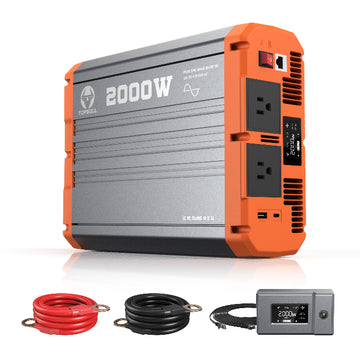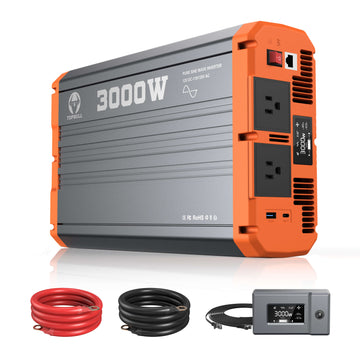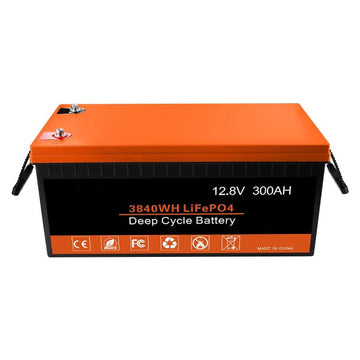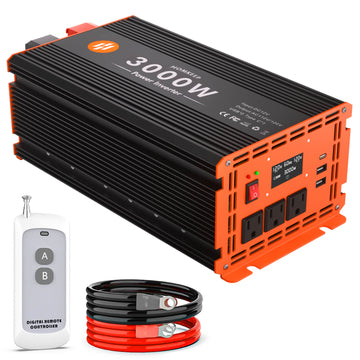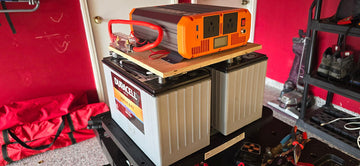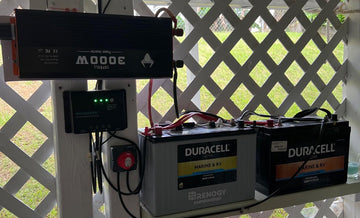A 2000W inverter is a reliable power source for running essential appliances when you're off the grid, on an RV trip, camping, or dealing with a power outage. But what can a 2000-watt inverter run? Understanding its capabilities is key to ensuring you don't overload it.
In this guide, we'll explore the appliances a 2000W inverter can handle, like refrigerators, TVs, microwaves, and more. We'll also discuss how long these devices can run, what kind of battery setup you need, and the best 2000W inverter to choose for your needs.
Overview of A 2000 Watt Inverter
A 2000W inverter converts DC power from a battery - a car battery, RV battery - into AC power. This conversion process is managed by electronic components and a control circuit to ensure stable output. Once converted, the AC power is supplied to connected devices. A 2000W inverter provides a power output of 2000 watts, which is the maximum load it can handle.
Different types of 2000W inverters could power different appliances. There are two main types of inverters based on their output waveform:
-
Pure sine wave inverters: They deliver clean, stable AC power, making them ideal for sensitive electronics such as laptops, refrigerators, and medical equipment. They ensure smooth operation and higher efficiency but come at a higher cost.
- Modified sine wave inverters: They are more affordable, but their power output is less stable. They work for basic appliances like power tools and some household devices, but they may cause inefficiency, extra noise, or even damage to sensitive electronics.
What Can I Run off a 2000-Watt Inverter?
2000W inverters can power a wide range of appliances, but the actual load depends on each device's running wattage and starting (surge) wattage.
Common Appliances Can be Used with A 2000w Inverter
A 2000W inverter is sufficient for running common household appliances and portable electronics. Here's a breakdown of devices by running power consumption:
-
Low-power devices (<500W) – A LED bulb (10w), TVs (250w), laptops (100w), WiFi routers (25w), ceiling fans (140w), and stereo systems (300w).
-
Medium-power devices (500W-1200W) – Refrigerators (200w), power tools (500 to 1000w), and coffee makers (1000w).
- High-power devices (1200W-2000W) – Microwaves (600 to 1200w), hair dryers (800-1600w), portable heaters (1200w), and toasters (800 to 1500w).
When using a 2000W inverter, ensure the total power of all connected devices does not exceed 2000W (rated power). For high-power devices, always check their peak wattage requirements before use. Or use them with a 4000w heavy-duty electric power inverter.
Manage High-power Appliances with Surge Wattage
When running multiple appliances with a 2000-watt power inverter simultaneously, you must also consider surge wattage — the temporary power spike when a device starts up. Many appliances, especially those with motors or heating elements, like electric water heaters, electric heaters, and ovens, require 1.5x to 3x their running wattage at startup. For example, if an electric heater has a rated power of 1,500W and a startup surge of 1,800W, then use an electric inverter rated with a peak power of at least 4,000W.
Failing to account for this can overload your inverter and cause it to shut down. In addition, avoid starting multiple devices with motors or heating elements simultaneously to prevent exceeding the inverter's surge power capacity.
How Long Will a 2000W Inverter Run Devices?
A 2000W inverter can run devices anywhere from a few minutes to several hours, depending on the battery capacity, load, and efficiency. While the inverter itself is rated for 2000W, the devices connected to it may draw less power, extending runtime. To determine how long a 2000W inverter can power your devices, follow these steps.
Step 1: Determine the Actual Load Power
In most cases, inverters are not necessarily operating at full load. In this case, it is essential to calculate the actual power being carried with your inverter's conversion efficiency (inverters are ~85-90% efficient). For example, say you want to power a 1500w appliance. Use this formula to calculate the actual load power:
The actual load power = Total Load (W) / Inverter Efficiency = 1500W / 90% ≈ 1666W
To answer the question of how long a 2000W inverter can run, we will stick with the load power of 2000W.
Step 2: Select the Battery Voltage (12V)
Most inverters work with 12V, 24V, or 48V systems. Higher voltages reduce current and improve efficiency. 12V systems are suitable for small appliances and the 24V systems are suitable for household appliances or long-term operation. Here we will have 12V batteries as an example.
Step 3: Calculate Required Battery Capacity
Use the formula: Battery Capacity (Ah) = (Actual Power in Watts × Runtime in Hours) / Battery Voltage (V)
Example: 12V 100Ah Lithium battery for 2 hours
- Required Battery Capacity = (2000W × 2h) / 12V ≈ 333 Ah
- Number of Lithium batteries: Can safely discharge to 80-90% DoD. Therefore: 333 Ah / (100Ah × 90%) ≈ 3.7
This means you would need approximately 4 of 12V 100Ah lithium batteries to run a 2000W power inverter for 2 hours.
Important Considerations
-
Inverter efficiency: Inverters typically operate at 85%-90% efficiency, meaning you might get slightly less runtime than calculated. For instance, a 90% efficient inverter would consume 10% more energy than expected.
-
Wire losses: Power loss can also occur due to wire resistance based on wire size. Be sure to use appropriately sized cables to minimize these losses.
- Battery Type Matters: Deep-cycle lithium batteries or AGM batteries are recommended for long-term use since they offer higher efficiency, longer lifespan, and deeper discharge capacity compared to standard lead-acid batteries.
Buying Tips: Best 2000W Pure Sine Wave Inverter

- Pure sine wave output – Safe for sensitive electronics like laptops, TVs, and medical equipment.
- High efficiency – Provides stable performance for your appliances with minimal energy loss.
- Multiple protection features – Includes overload, overheating, and short circuit protections to ensure safety.
- Versatile use – Perfect for home backup, RVs, and solar systems.
- Convenient display and outlets – Comes with a digital display and multiple power and USB outlets, allowing you to connect several devices simultaneously.
FAQs About Using a 2000W Inverter
Can a 2000w inverter run a house?
A 2000-watt inverter can provide up to 2000 Watts of continuous power. Typically, this may be enough to power a smaller home or certain basic appliances during a power outage. For larger homes with higher power requirements, a 2000 w inverter may not be enough to power the entire house at once.
Can a 2000W Inverter Run a Refrigerator and a Microwave at the Same Time?
No. Running a refrigerator (~150-800W) and a microwave (~800-1500W) simultaneously can easily exceed 2000W. In addition to the combined running watts, the startup surge—especially from the refrigerator's compressor—can cause a spike in power demand, potentially overloading the inverter.
If you need to use both appliances at once, consider either:
- Using them separately.
- Upgrading to a higher-wattage inverter (e.g., a 3000W inverter) if needed.
Related Information: What Can A 3000-Watt Inverter Run: Essential Power Guide
Do I Need a Pure Sine Wave or Modified Sine Wave 2000W Inverter?

2000w Pure sine wave inverters are ideal for modern electronics, providing clean, stable power for sensitive appliances like refrigerators, microwaves, and medical equipment. They ensure smooth and efficient operation without causing overheating.
While 2000w modified sine wave inverters are typically cheaper, they can lead to inefficiency and potential damage to sensitive devices due to unstable power output. If you're powering valuable or delicate appliances, it's recommended to opt for a pure sine wave inverter to avoid potential risks.
For a detailed comparison, head to our post: Pure vs Modified sine wave inverter [Detailed Guide]
Conclusion
Now, you know what a 2000W inverter can run. It is more than capable of running essential home appliances, but it's important to ensure you have the right battery setup and manage your load properly. Don't forget to factor in surge watts in addition to running watts to avoid overloading the inverter.
If you're still unsure which inverter to choose, the TOPBULL 2000W Pure Sine Wave Inverter is a reliable, cost-effective choice for most needs. However, always check the wattage and battery requirements based on your specific appliances and use case before purchasing to ensure the best match for your power needs.

